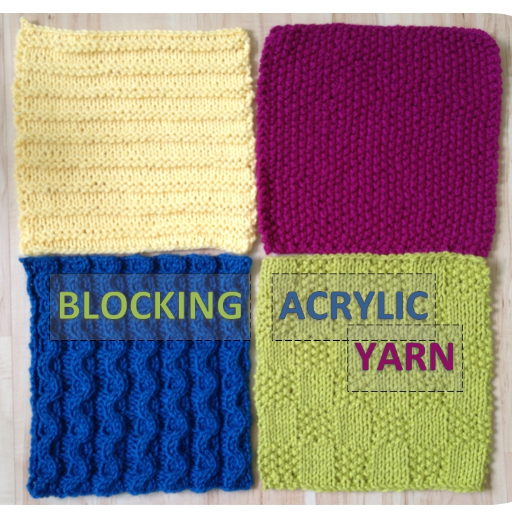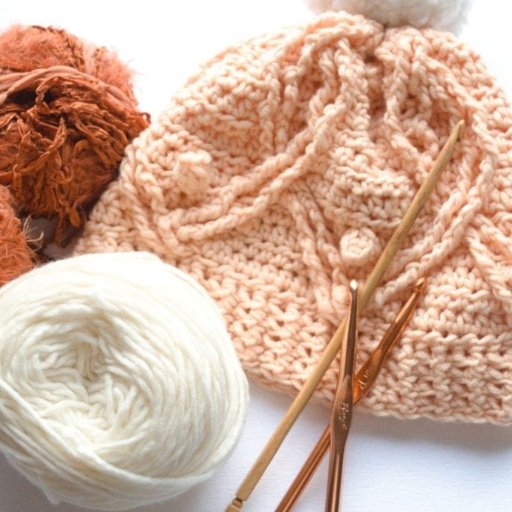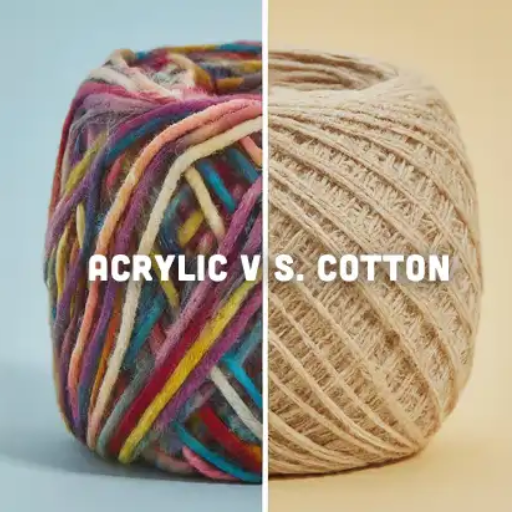Blocking is one of the essential finalizing steps in any yarn project because it provides shape, size, and polish to the workpiece. While wool, a natural fiber, responds favorably to wet and steam blocking techniques, acrylic yarn, being synthetic in nature, requires a more bespoke approach. This guide will focus on optimal techniques for blocking acrylic yarn so that it meets a benchmark level of professionalism in each finished project.
In the first sections of this guide, we start by defining blocking and describing its importance, particularly for projects made out of acrylic yarn. Next, we cover the science of acrylic fibers, their specific properties, and how they affect the overall structure and behavior of the material when subjected to heat. After that, we provide a thorough procedure for blocking acrylic yarn or steam blocking with other modifications tailored for acrylic yarn. By the time you finish this guide, you will be able to block acrylic yarn in a manner that fulfills all structural and aesthetic expectations for the workpiece. The guide should serve as the final touch for any loved garments, snug blankets, or even elaborate ornamental creations made using acrylic yarn.
Can You Really Block Acrylic Yarn? Understanding the Basics

Indeed, you can block acrylic yarn; however, the method differs greatly from blocking natural fibers such as wool. Natural acrylic does not absorb water or have the stretchable nature of natural fibers, so wet blocking methods are not useful. Instead, methods such as steam blocking which relax and shape acrylic fibers are used. If done right, blocking can improve the overall look, consistency, drape, and elegance of your projects, making it a crucial step for achieving professional looking results.
Why Acrylic Yarn Can Be Blocked Despite Common Misconceptions
Due to its ability to hold an altered shape when heat is applied, acrylic yarn can be blocked efficiently despite the misconceptions. Unlike natural fibers, acrylic fibers are thermoplastic which means they can be altered with heating methods. Techniques like steam blocking, which utilizes heat and moisture to soften the fibers, can set the yarn into a new shape once cooled. While acrylic’s lack of elasticity and absorbent qualities makes wet blocking infeasible, steam blocking provides durability and precision in shape, making the project polished and professional looking.
Differences Between Blocking Acrylic Yarn vs. Wool
The methods for blocking acrylic yarn differs from wool yarn due to the fundamental nature of these fibers. Wool is a natural fiber that is highly absorbent, elastic, and protein-based. Thus, wool is best suited for wet blocking. In this technique, the wool is soaked in water, pinned it to shape, and set to air dry. This method enables the wool to absorb water and set to shape.
Acrylic yarn, being synthetic and a thermoplastic, lacks the absorbency and elasticity of wool. Because water does not manipulate acrylic fibers, wet blocking is ineffective. Steam blocking is the best alternative when it comes to blocking acrylic yarn. In steam blocking, heat and moisture is applied to the fibers to soften them. The softened fibers can then be reshaped to a desired configuration and set to cool. Careful application of heat is essential when steam blocking acrylic to avoid damaging the synthetic fibers.
While either of the two materials can be blocked to achieve a more refined finish, the choice of blocking method is dictated by the unique characteristics of each fiber type and ensures optimal results for the specific material used.
When Do Acrylic Projects Need Blocking?
Blocking is used in projects involving acrylic when more fine-tuned shapes or sizes (measured systematically) are required, for example in maintaining uniformity in garments, pattern aligning, or edge setting for planar surfaces. As opposed to other fibers, acrylic does not have any inherent moldability. This means that blocking is most helpful after completing lacy designs or modular pieces in crafting. Blocking also improves the aesthetics of the finished product by setting stitches, contouring, and forming a clean professional appearance. Use of steam blocking must be done with care so as to not apply too much heat which will destroy the fiber components.
Steam Blocking: The Most Effective Method for Acrylic Yarn

The technique used in steam blocking acrylic yarns is steam relax which is a process of applying moist heat to relax and set stitches into place. Below are the necessary steps that will enable you to steam block safely and effectively.
- Prepare the Work Area
Using a blocking mat or any other surface which is suitable for pinning the piece, use T-pins to hold the fabric in predetermined shape while work is in progress. Of use during this step are T-Pins which are rust free.
- Position the Project
Place the completed project on the blocking surface. If the piece requires some stretching, ensure that it is pinned at the edges with T-pins where necessary.
- Use a Steam Source
Use a handheld steam iron or a garment steamer. Ensure that the source is around 1 to 2 inches away from the fabric to allow the steam to permeate without coming into contact with the yarn.
- Apply and Observe
Move the steam gently over the project ensuring that there is even distribution. Avoid overheating the project because that might melt the fibers. Regularly evaluate if the desired shape has been set.
- Allow to Cool
Let the fabric cool after being shaped and steamed while still pinned in place which helps the fabric maintain its shape.
These steps help polish steam blocking project transforming them into well defined pieces suitable for gifts, to display or personal use.
How to Steam Block Without Killing the Yarn
To avoid damage while steam blocking acrylic yarn, it is strongly recommended to adhere to these brief but crucial instructions:
- Use Low to Medium Heat Settings
Using a steaming device or iron, always remember to put it on low to medium heat. High temperatures will melt or alter synthetic blends, risking the structure of the yarn.
- Maintain Proper Distance
Keep the steam source of the device about one to two inches above the surface of the yarn to not risk direct heat contact. Placing a pressing cloth between the steam and the yarn adds another layer of protection.
- Steam in Small Sections
Do not over saturate the material with steam as this could lead to loss of control. This will ensure that ‘killing’ the yarn is not an issue through features such as overheating or lack of texture.
- Test on a Swatch First
Before the final project, it is crucial to test the steaming technique on a small piece of fabric cut from the same yarn as the main project. This helps ensure that the techniques chosen will work smoothly with no surprises.
With these methods, exceptional suppleness, textural definition, and aesthetic appeal within the yarn projects will be maintained throughout the steam blocking process.
Tools Needed: Steamer, Steam Iron, and Blocking Boards
To steam block acrylic yarn projects, some tools are needed in order to achieve the best precision and results.
1. Steamer – A handheld garment steamer is best used fro controlling and ensuring that moisture is correctly applied to the project. As well, having a set of blocking boards or grid lines is useful in helping achieve symmetry and overall uniformity when pinning the project. These practices come highly recommended by industry experts.
2. Steam Iron – An iron that is capable of both gentle pressing and steaming at adjustable heat settings provides further alternatives for achieving similar results, while requiring care to not directly contact the steam iron with the yarn.
3. Blocking Boards – These serve not only as flat surfaces for pinning but also provide stability. Additionally, they assist in the horizontal and vertical alignments that are necessary to achieve congruence for all parts of the project.
4. Rust proof pins/blocking wires – While not requred, these two options are suggested in order to better support the project to retain its shape during cooling.
The combination of the above tools allows for proper steam blocking while maintaining best practices laid out by expert sources on acrylic yarn steam blocking.
Step-by-Step Steam Blocking Process for Acrylic
- Prepare the Workspace
Select a flat surface with heat resistance such as an ironing board or blocking board. Check that the surface is clean and free of any objects that may snag the yarn. Set out the intended project and make sure it is properly aligned using gridlines, if available.
- Position the Project
Gently shape the acrylic piece to the exact measurements, stretching it as needed. Use blocking wires, or rust-proof pins, to retain even tension across the item while securing it.
- Set Up the Steam Source
Fill the handheld steamer or steam iron with water and switch it on to the appropriate setting for acrylics (consult your tool’s manual). Do not let the soleplate of the iron rest directly on the yarn.
- Apply Steam Evenly
Position the steam source approximately 1 – 2 inches above the acrylic project. Without lingering too long in one place, move it evenly across the surface, making sure that steam reaches the fibers, but does not drown them. Do not leave a single area of application for too long as it may result in damage to the piece.
- Allow to Cool and Set
When the project has been adequately steamed and the yarn locked into place, let it cool completely while still pinned to allow the project to maintain its intended shape and the acrylic yarn to set.
- Inspect the Final Result
Gently unpin the project and check it for irregularities. If necessary, re-pin and re-steam for greater accuracy. Ensure the completed item’s dimensions within tolerance limits before either using or storing it.
This follows professional standards pertaining to the use of acrylic yarn while maximizing durability, shape retention, and aesthetics.
Alternative Blocking Methods for Acrylic Yarn

Wet blocking is rarely done for acrylic fibers because of their water-shunning characteristics. It can still be useful, however, when more delicate shaping is required. For wet blocking, the piece is submerged in cool water, gently squeezing—without twisting—to remove any excess moisture. The piece is then laid flat on a blocking mat and pinned in place to air dry completely. Moisture removal with this technique can be suited for lightweight projects, although thicker works may require more rigidity than this method offers.
Cold blocking entails adjusting the shape of an acrylic project without the application of heat or water. Simply pin the dry item into the preferred shape on a blocking mat. The correct position will need to be maintained for a sustained period of time, roughly 1-2 days, in order for the tension to set naturally in the project’s fibers. For pieces that undergo very little reshaping, cold blocking is advantageous as the procedure avoids the possibility of heat distortion.
Wet Blocking Acrylic: Does It Work?
Wet blocking acrylic is an appropriate method in some cases, however, it needs to be done with precision due to synthetic fibers. Unlike wool, acrylic has no memory. Thus, reshaping it doesn’t guarantee a durable hold over time. Although temporarily effective, the process of submerging the item in cool water and pinning it into a particular shape is not ideal due to the inelastic nature of acrylic fibers. Beyond a certain limit, stretching during wet blocking will irreversibly alter the material’s shape. In general, less is more when it comes to wet blocking, particularly when only a small change in shape or tension is required.
Spray Blocking Technique for Small Acrylic Projects
Spray blocking is a good option for small acrylic projects as it does not cause large distortion to the pieces. Gather the piece and place it flat on a spraying blocking mat or any other sturdy surface that can be pinned. Nail the edges of the piece with rust-free nails into the shape they want while making sure they don’t pull too much on the edges to unbalance the utensils. Fill the spray bottle with water that is clean and cold after which they need to sprinkle some water, not enough to make the project wet but enough to dampen it. Remove the pins after the piece has dried completely while pinned in place. This method has the least chance of overstretching and damage ensuring that during the entire process nothing happens to the intricate designs while providing perfect tension adjustments to the acrylic materials.
Using a Washer and Dryer for Simple Acrylic Blocking
The washer and dryer method used for blocking acrylic projects is simple and works well for pieces that require minimal refinement to their texture or shape. First, to keep the piece safe throughout the process, place the acrylic in a pillowcase or laundry bag. Select the delicate cycle on the washing machine and fill it with cold water. Make sure to skip on washing powders, as the weak fibers may be hindered. After the cycle ends, move the piece to the dryer—set it to low or no heat to be safe, as too much heat could harm acrylic fibers. Take it off the heat while it’s still a little damp. It is critical that, at this point, the shape is already set to the desired dimensions. This technique is best for uncomplicated designs, while guaranteeing that strain on the material is minimal during the drying process.
Blocking Specific Acrylic Projects: Tips and Techniques

For effective blocking of acrylic projects, the wet blocking technique is highly effective. To begin, presoak the piece in lukewarm water mixed with mild detergent. Let the piece soak for 15 to 30 minutes. Gently squeeze the water out without wringing the fibers. Place the item on a clean, flat surface, such as a blocking mat, and manipulate it to the desired dimensions. Use stainless steel pins to hold the edges and other fine details as required. Ensure that the project dries completely before unpinning it so that the shape is retained.
To steam block an acrylic project, it has to be secured on a flat surface like a blocking mat and make sure it is correctly shaped. With a handheld steamer or the steam setting of the iron, hold it 1 to 2 inches above the surface of the project, never putting direct pressure on it. Carefully steam the item while letting steam and heat relax the fibers. The item should be allowed to cool after steaming and should be in the desired shape. Make sure to check first on an inconspicuous small area of the project to ensure that the acrylic does respond well to the steaming process.
How to Block Acrylic Sweaters and Garments
For every acrylic sweater or garment, start out by either washing the piece or lightly misting it with water so the fibers can relax. Place the piece of clothing on a blocking mat flat, shaping it to the set measurements you intend to achieve, and pinning it with rust free pins a long the seams and edges. Be sure to make all portions stretches evenly to the fabric so there isn’t warping.
Start by giving the garment a good steam, then placing it on a flat surface that doesn’t react to heat.When using a steam iron, hold it between 1 to 2 inches away so there’s no direct contact. Move the steam across the piece. It is also important to leave the pinned garment unused until all the pins used to retain the shape are cold. Ensure to test any holes before creating them to ensure there is no damage to the fibers.
Blocking Acrylic Crochet and Knit Baby Blankets
Because of the fiber’s synthetic nature, wet blocking remains an efficient method for acrylic crochet or knit baby blankets. Begin by soaking the blanket in lukewarm water mixed with a mild, fiber-safe detergent for about 15-30 minutes. After this, gently squeeze excess water without twisting or wringing the fabric, as that may distort the shape. Lay the blanket flat on a blocking mat or clean towel while applying gentle pressure to stretch it to the desired dimensions. Remember to use rust-free pins to secure the most significant points, like corners and edges – this will maintain the right amount of tension for the entire piece. Do not move the position of the blanket until the blanket is completely dry, as the fibers need ample time to set properly.
Steam blocking can also be applied to acrylic baby blankets when a more accurate shape or a crisper finish is needed. Position the preheated blanket on a smooth and clean heat resistant surface, as the surface must be perfectly smooth to enhance the edges of the imprints. Maintain a distance of 1–2 inches from the fabric with a steam iron and apply steam gradually across the blanket. Pay particular attention to the sewing lines and the corners of the blanket. Do not touch the surface as this will cause melting and destruction of the acrylic fibers. Once the steam is applied, allow the blanket to maintain the shape it was pinned in until it cools off entirely. It is important to always double check if the technique being used will harm the fibers by testing on the less visible section of the object before starting to fully utilize the steam.
Blocking Acrylic Lace and Detailed Stitch Work
Lace blocking acrylic pieces requires a careful steam treatment so that the more intricate stitch work does not get distorted. Carefully place the piece on the blocking mat ensuring that the entire structure remains flat while also using acrylic pins to fix each point . It is best to use steam blocking because it doesn’t apply too much pressure on delicate fibers. It is best to hold the steam iron/hand steamer 1-2 inches away from the fabric so that no direct heat is applied, while concentrating on even steam application. In order to define the edges and the details of the lace, adjust pin placement to enable focusing on defining the extrapolated edges. It is imperative that the fabric is allowed to dry in the pinned stance, this ensures that the stitch work will maintain the desired form. A good practice is to steam test a small section of the fabric before proceeding. Using best practice when steaming makes certain the stability without compromising the structure of the lace.
Common Problems When Blocking Acrylic Yarn

Unique issues may arise while blocking acrylic yarn as a result of its synthetic composition and sensitivity to heat. Problems may stem from improper application of heat resulting in melting or the loss of elasticity inherent in the yarn. Excessive temperatures or close steam application is a common culprit. Distortion and uneven tension in the finished product is often caused by over-stretching the fabric while blocking it. Crafters are also likely to experience problems with shape retention as blocking does not yield the same results for acrylic as it does for natural fibers. To avoid these challenges, maintain a distance of 1-2 inches from the steam source and utilize a gentle steam method, while refraining from excessive pulling or pinning the fabric. It is always advisable to test the preferred method on a small swatch first to avoid unwanted mishaps.
Avoiding the “Kill” Effect That Can Melt the Yarn
The harm caused to acrylic yarn by overheating is referred to as the ‘kill’ effect’. In this case, the acrylic fibers melt and lose their elasticity due to excessive heat. To prevent these effects from occurring, one should carefully control the steaming process. A steam iron and a steamer should be set to the lowest temperature possible reserved for synthetic cloths. Steam should always be at least 1-2 inches above the fabric surface, never in direct contact with it, and can harm fabrics. Along with a pressing cloth, steam can also be prevented by pressing between the cloth and other fabrics. Prolonged exposure to even moderately high temperatures can destabilize the material, so precaution should be taken. By following these guidelines yarn will remain intact and undamaged during the blocking process.
Maintaining Stitch Definition in Blocked Acrylic Projects
It is equally necessary to be precise and gentle while blocking acrylic projects in order to preserve stitch definition. Start with the project set up on a horizontal padded surface. Make sure each stitch is positioned correctly. Use rust-proof pins to lightly pin the edges or any areas that require specific shaping, without pulling them too much. When steam vapping, hold the steam tool at least 1 to 2 inches from the fabric so that there is no distortion. Do not press down on the fabric, as this directly compresses the stitches and alters their texture. Allow the garment to cool down completely before removing any pins in order to maintain the crispness of the stitches. Following these tips ensures an elegant polish that highlights the stitchwork in your acrylic project.
References
Frequently Asked Questions (FAQ)
Q: What is the best way to block acrylic yarn?
A: The best way to block acrylic yarn is through steam blocking. This method allows you to shape your finished piece without damaging the fibers. You can use a hair dryer or a steam iron to achieve the desired results.
Q: Do I need to block my finished piece made with acrylic?
A: While it is not always necessary to block acrylic items, it can enhance the appearance and shape of your project. If you want to block, consider the method of blocking that is suitable for your specific yarn and project.
Q: Can I machine wash items made with acrylic after blocking?
A: Yes, you can machine wash acrylic items, but be sure to check the yarn label for specific care instructions. Some acrylic yarns may be more durable to washing than others.
Q: How does blocking affect the acrylic fibers in my project?
A: Blocking can help to relax the stitches and give your finished piece a polished look. However, if you use excessive heat, you might kill the acrylic fibers, so be cautious with your steam settings.
Q: What should I do with the ends before blocking?
A: It is essential to weave in any ends before blocking your acrylic item to ensure a neat finish. This will help secure the yarn and prevent it from unraveling during the blocking process.
Q: When should I block my acrylic project?
A: Ideally, you should block your project after you have completed all knitting and crocheting but before you sew together any pieces. This ensures that each piece retains its shape and size.
Q: Is it effective to use blocking pins with acrylic yarn?
A: Yes, blocking pins can be very effective when blocking acrylic yarn. They help hold the shape of your project as it dries, ensuring that it maintains the desired dimensions.
Q: What if I cannot block my acrylic project?
A: If you cannot block your acrylic item, you can still shape it by gently washing and laying it flat to dry. This won’t be as effective as traditional blocking, but it can help relax the fibers slightly.



















